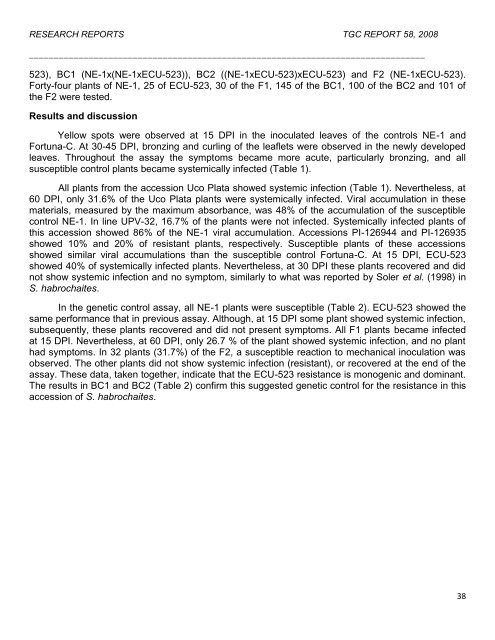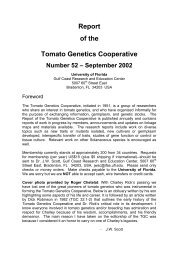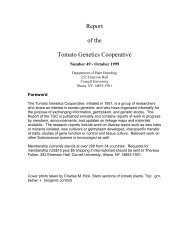Report of the Tomato Genetics Cooperative Number 58
Report of the Tomato Genetics Cooperative Number 58
Report of the Tomato Genetics Cooperative Number 58
Create successful ePaper yourself
Turn your PDF publications into a flip-book with our unique Google optimized e-Paper software.
RESEARCH REPORTS TGC REPORT <strong>58</strong>, 2008<br />
________________________________________________________________________________<br />
523), BC1 (NE-1x(NE-1xECU-523)), BC2 ((NE-1xECU-523)xECU-523) and F2 (NE-1xECU-523).<br />
Forty-four plants <strong>of</strong> NE-1, 25 <strong>of</strong> ECU-523, 30 <strong>of</strong> <strong>the</strong> F1, 145 <strong>of</strong> <strong>the</strong> BC1, 100 <strong>of</strong> <strong>the</strong> BC2 and 101 <strong>of</strong><br />
<strong>the</strong> F2 were tested.<br />
Results and discussion<br />
Yellow spots were observed at 15 DPI in <strong>the</strong> inoculated leaves <strong>of</strong> <strong>the</strong> controls NE-1 and<br />
Fortuna-C. At 30-45 DPI, bronzing and curling <strong>of</strong> <strong>the</strong> leaflets were observed in <strong>the</strong> newly developed<br />
leaves. Throughout <strong>the</strong> assay <strong>the</strong> symptoms became more acute, particularly bronzing, and all<br />
susceptible control plants became systemically infected (Table 1).<br />
All plants from <strong>the</strong> accession Uco Plata showed systemic infection (Table 1). Never<strong>the</strong>less, at<br />
60 DPI, only 31.6% <strong>of</strong> <strong>the</strong> Uco Plata plants were systemically infected. Viral accumulation in <strong>the</strong>se<br />
materials, measured by <strong>the</strong> maximum absorbance, was 48% <strong>of</strong> <strong>the</strong> accumulation <strong>of</strong> <strong>the</strong> susceptible<br />
control NE-1. In line UPV-32, 16.7% <strong>of</strong> <strong>the</strong> plants were not infected. Systemically infected plants <strong>of</strong><br />
this accession showed 86% <strong>of</strong> <strong>the</strong> NE-1 viral accumulation. Accessions PI-126944 and PI-126935<br />
showed 10% and 20% <strong>of</strong> resistant plants, respectively. Susceptible plants <strong>of</strong> <strong>the</strong>se accessions<br />
showed similar viral accumulations than <strong>the</strong> susceptible control Fortuna-C. At 15 DPI, ECU-523<br />
showed 40% <strong>of</strong> systemically infected plants. Never<strong>the</strong>less, at 30 DPI <strong>the</strong>se plants recovered and did<br />
not show systemic infection and no symptom, similarly to what was reported by Soler et al. (1998) in<br />
S. habrochaites.<br />
In <strong>the</strong> genetic control assay, all NE-1 plants were susceptible (Table 2). ECU-523 showed <strong>the</strong><br />
same performance that in previous assay. Although, at 15 DPI some plant showed systemic infection,<br />
subsequently, <strong>the</strong>se plants recovered and did not present symptoms. All F1 plants became infected<br />
at 15 DPI. Never<strong>the</strong>less, at 60 DPI, only 26.7 % <strong>of</strong> <strong>the</strong> plant showed systemic infection, and no plant<br />
had symptoms. In 32 plants (31.7%) <strong>of</strong> <strong>the</strong> F2, a susceptible reaction to mechanical inoculation was<br />
observed. The o<strong>the</strong>r plants did not show systemic infection (resistant), or recovered at <strong>the</strong> end <strong>of</strong> <strong>the</strong><br />
assay. These data, taken toge<strong>the</strong>r, indicate that <strong>the</strong> ECU-523 resistance is monogenic and dominant.<br />
The results in BC1 and BC2 (Table 2) confirm this suggested genetic control for <strong>the</strong> resistance in this<br />
accession <strong>of</strong> S. habrochaites.<br />
38





